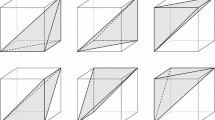Summary.
The Cauchy-Born rule postulates that when a monatomic crystal is subjected to a small linear displacement of its boundary, then all atoms will follow this displacement. In the absence of previous mathematical results, we study the validity of this rule in the model case of a 2D cubic lattice interacting via harmonic springs between nearest and diagonal neighbours. Our main result is that for favourable values of the spring constants and spring equilibrium lengths, the CB rule is actually a theorem.
Simple counterexamples show that for unfavourable spring parameters or large displacements the CB rule fails. Moreover the resulting overestimation of the lattice energy per unit volume by the CB rule cannot be cured by convexification (let alone quasiconvexification) of the CB energy.
The main tool in our proof is a novel notion of lattice polyconvexity which allows us to overcome the difficulty that the elastic energy as a function of atomic positions can never be convex, due to frame-indifference.
Similar content being viewed by others
Author information
Authors and Affiliations
Rights and permissions
About this article
Cite this article
Friesecke, Theil Validity and Failure of the Cauchy-Born Hypothesis in a Two-Dimensional Mass-Spring Lattice . J. Nonlinear Sci. 12, 445–478 (2002). https://doi.org/10.1007/s00332-002-0495-z
Issue Date:
DOI: https://doi.org/10.1007/s00332-002-0495-z




